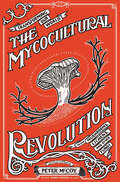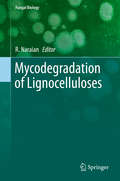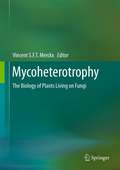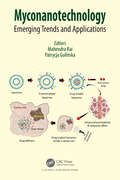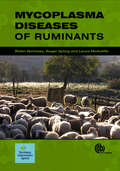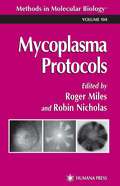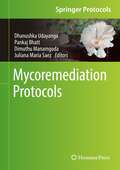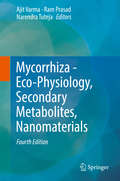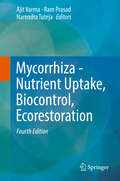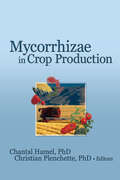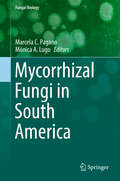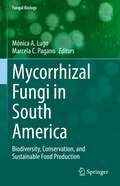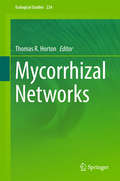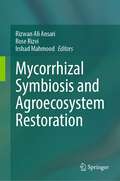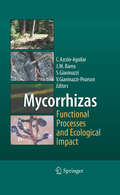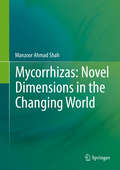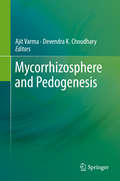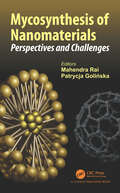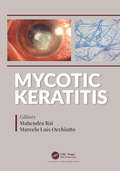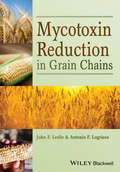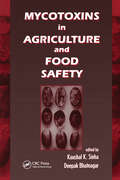- Table View
- List View
Mycocultural Revolution, The: Transforming Our World with Mushrooms, Lichens, and Other Fungi
by Peter McCoyDiscover the glorious world of mushrooms, lichens, and micro fungi, as described by Peter McCoy, one of today&’s foremost experts in the field. Covering the essential information and skills for identifying, cultivating, and celebrating the uniqueness of fungi, this book enables anyone to quickly and easily engage in the art and science of mycology—the study of fungi. Mycology offers vast opportunities to enhance our lives, support our communities, and heal the environment. This first-of-its-kind introductory text is accessible for anyone just getting started in mycology, as well as for those seeking a fresh perspective on this important science.Learn general mycological facts, essential information and skills for identifying common mushroom types, foraging tips, delicious recipes, a growing guide, mycoremediation (using fungi to treat contaminated areas in our environment), mushroom-based crafts, and so much more!With a foreword by Robert Rogers, author of The Fungal Pharmacy.
Mycodegradation of Lignocelluloses (Fungal Biology)
by R. NaraianThis book provides a knowledge-based view to the dynamic capabilities in an organization. The author integrates two existing views on gaining competitive advantage: the Knowledge View which suggests that the capability of organizations to learn faster than competitors is the only source of competitiveness; and the Dynamic Capability View which speculates that a fi rm’s competitive advantage rests on it’s ability to adapt to changes in the business environment. Using the IT sector in India as a case study, this book provides and tests a new framework—Knowledge-Based Dynamic Capabilities—in the prediction of competitive advantage in organizations.
Mycoheterotrophy
by Vincent MerckxOver the course of evolution, several plant lineages have found ways to obtain water, minerals, and carbohydrates from fungi. Some plants are able exploit fungi to such an extent that they lose the need for photosynthesis. The ability of a plant to live on fungal carbon is known as mycoheterotrophy. This intriguing process has fascinated botanists for centuries, yet many aspects of mycoheterotrophy have remained elusive for a long time. Mycoheterotrophy: The Biology of Plants Living on Fungi explores the biology of mycoheterotrophs, offering general insights into their ecology, diversity, and evolution. Written by renowned experts in the field and bolstered with lavish illustrations and photographs, this volume provides a thematic overview of different aspects of mycoheterotrophy. Comprehensive and readily accessible, Mycoheterotrophy: The Biology of Plants Living on Fungi is a valuable resource for researchers and students who are interested in the process of mycoheterotrophy.
Myconanotechnology: Emerging Trends and Applications
by Mahendra Rai Patrycja GolińskaMyconanotechnology is a highly interdisciplinary science emerging at a fast pace and has garnered the attention of nanotechnologists, mycologists, biomedical experts, and agriculture scientists, among others. For the last decade, there has been tremendous progress in this field owing to its wider and more effective applications. In this book, the authors have attempted to discuss different evolving trends in medicine, food, agriculture, veterinary, environment, and textiles. Globally contributed by eminent authors and experts, the present book contains valuable chapters on the diverse aspects of Myconanotechnology and thus would be essential reading for academicians. This book will cater to the need of postgraduate and research students in fungal biology, microbiology, chemistry, nanotechnology, biotechnology, and pharmacology.
Mycoplasma Diseases of Ruminants
by Robin Nicholas Roger Ayling Laura McauliffeMycoplasmas are the smallest of free-living organisms and are intermediate between viruses and bacteria. Many species thrive as parasites in animal (including human) hosts. This book is based on proceedings of a conference held in Palermo, Italy. It reviews some of the most important mycoplasma diseases of sheep, goats and cattle including contagious bovine pleuropneumonia, contagious agalactia and calf pneumonia, which are listed by the OIE because of their economic implications.
Mycoplasma Protocols
by Robin A. Nicholas Roger J. MilesThis is a collection of cutting-edge mycoplasma methods for the detection, isolation, identification, characterization, and genetic manipulation of the pathogenic mycoplasmas. These step-by-step methods are crafted for successful reproducibility and include biochemical, genetic, and molecular techniques essential to understanding pathogenecity and adhesion to host cells. They also cover the detection of mycoplasmas in cell cultures, an important tool not only in viral diagnosis and research, but also in the production of vaccines and various biological products.
Mycoremediation Protocols (Springer Protocols Handbooks)
by Pankaj Bhatt Dhanushka Udayanga Dimuthu Manamgoda Juliana Maria SaezThis volume provides a wide range of aspects related to mycoremediation, which can be applied for both basic and advanced multidisciplinary research. Chapters guide readers through screening of fungi, Polyaromatic Hydrocarbons (PAHs), textile dyes, pesticides, bioreactors, molecular methods, redictive Mycology and Proteomics approaches to select fungi, elucidating biological mechanisms, and fungal laccase enzyme-based biosensors for the detection of environmental contaminants. Authoritative and cutting-edge, Mycoremediation Protocols aims to be a practical guide on the functional properties of poorly known applications of fungi in order to find solutions for increasing environmental problems.
Mycoremediation and Environmental Sustainability: Volume 3 (Fungal Biology)
by Ram Prasad S. Chandra Nayak Ravindra Nath Kharwar Nawal Kishor DubeyVolume 3 covers recent research with expanded coverage on this important area of remediation. Mycoremediation is the form of bioremediation in which fungi-based technology is used to decontaminate the environment. Fungi are among the primary saprotrophic organisms in an ecosystem, as they are efficient in the decomposition of organic matter. Wood-decay fungi, especially white rot, secretes extracellular enzymes and acids that break down lignin and cellulose. Fungi have been proven to be a very cost-effective and environmentally-friendly way for helping to remove a wide array of toxins from damaged environments or wastewater. These toxins include heavy metals, persistent organic pollutants, textile dyes, leather tanning industry chemicals and wastewater, petroleum fuels, polycyclic aromatic hydrocarbon, pharmaceuticals and personal care products, pesticides and herbicides, in land, fresh water and marine environments. Bioremediation of toxic organics by fungi is the most sustainable and green route for cleanup of contaminated sites and we discuss the multiple modes employed by fungi for detoxification of different toxic and recalcitrant compounds including prominent fungal enzymes viz., catalases, general lipase, laccases, peroxidases and sometimes intracellular enzymes, especially the cyrochrome P450 monooxygeneses.Fungi play an important role in the biogeochemical cycling of manganese and other redox-active metals, which is related to their ability to survive radiation and other oxidative challenges.This book covers recent research with more detail on the various types of fungi and associated fungal processes used to clean up wastes and wastewaters in contaminated environments, and discusses their potential for environmental applications.
Mycorrhiza - Eco-Physiology, Secondary Metabolites, Nanomaterials
by Narendra Tuteja Ajit Varma Ram PrasadThis is the fourth updated and revised edition of a well-received book that emphasises on fungal diversity, plant productivity and sustainability. It contains new chapters written by leading experts in the field. This book is an up-to-date overview of current progress in mycorrhiza and association with plant productivity and environmental sustainability. The result is a must hands-on guide, ideally suited for agri-biotechnology, soil biology, fungal biology including mycorrhiza and stress management, academia and researchers. The topic of this book is particularly relevant to researchers involved in mycorrhiza, especially to food security and environmental protection. Mycorrhizas are symbioses between fungi and the roots of higher plants. As more than 90% of all known species of plants have the potential to form mycorrhizal associations, the productivity and species composition and the diversity of natural ecosystems are frequently dependent upon the presence and activity of mycorrhizas. The biotechnological application of mycorrhizas is expected to promote the production of food while maintaining ecologically and economically sustainable production systems.
Mycorrhiza - Nutrient Uptake, Biocontrol, Ecorestoration
by Narendra Tuteja Ajit Varma Ram PrasadThis is the fourth updated and revised edition of a well-received book that emphasises on fungal diversity, plant productivity and sustainability. It contains new chapters written by leading experts in the field. This book is an up-to-date overview of current progress in mycorrhiza and association with plant productivity and environmental sustainability. The result is a must hands-on guide, ideally suited for agri-biotechnology, soil biology, fungal biology including mycorrrhiza and stress management, academia and researchers. The topic of this book is particularly relevant to researchers involved in mycorrhiza, especially to food security, plant microbe interaction and environmental protection. Mycorrhizas are symbioses between fungi and the roots of higher plants. As more than 90% of all known species of plants have the potential to form mycorrhizal associations, the productivity and species composition and the diversity of natural ecosystems are frequently dependent upon the presence and activity of mycorrhizas. The biotechnological application of mycorrhizas is expected to promote the production of food while maintaining ecologically and economically sustainable production systems.
Mycorrhizae in Crop Production
by Chantal Hamel Christian PlenchetteDesign cropping practices that make the most of the contribution of AM fungi Mycorrhizae in Crop Production is a comprehensive guide to the use of arbuscular mycorrhizal fungi (AMF) in developing sustainable cropping systems. This unique book examines how AMF benefit crop plants in both greenhouse and field crop production. It’s als
Mycorrhizal Fungi in South America (Fungal Biology)
by Marcela C. Pagano Mónica A. LugoThis new book shows the work done by researchers dedicated to the study of different mycorrhizas types, the fungal species associated and their distribution influenced by geographical and environmental factors among the different South American biogeographic regions. The exclusive biotic and abiotic characteristics delimit natural ecosystems with uniques biological communities, where mycorrhizologists have investigated plant symbioses in those ecosystems for decades, providing data from Venezuelan Great Savannah, Andes, Puna, Chaco, Caatinga, Monte, Atlantic Forest, Marginal Forest, Cerrado, Patagonia, Yungas, Rainforest, Andean-Patagonian Forests, and Antarctic section. In these environments, different mycorrhizal associations (arbuscular / ericoid / orchidoid / ectomycorrhizal / mycoheterotrophic) are present in herbaceous plants, shrubs, and trees. Mycorrhizal associations were studied from different researching points of view (biodiversity, biological invasions, biotic / abiotic disturbances, altitudinal variations, seasonal changes, land uses). The aim of this Book is to compile research on mycorrhizal fungi and their associations in environments of South America, throughout the synthesis of information from natural and anthropogenic related environments. The book focuses in different bioregions of South America from tropical areas to the southern cone, and it will be useful to those who work on plant-fungal interactions in different vegetation types and in agricultural lands from South America and worldwide.
Mycorrhizal Fungi in South America: Biodiversity, Conservation, and Sustainable Food Production (Fungal Biology)
by Marcela C. Pagano Mónica A. LugoIn order to feed the world, global agriculture will have to double food production by 2050. As a result, the use of soils with fertilizers and pesticides in agronomic ecosystems will increase, taking into account the sustainability of these systems and also the provision of food security. Thus, soil ecosystems, their health, and their quality are directly involved in sustainable agronomical practices, and it is important to recognize the important role of soil microbial communities such as mycorrhizal fungi, their biodiversity, interactions, and functioning. Soil ecosystems are under the threat of biodiversity loss due to an increase of cultivated areas and agronomic exploitation intensity. Also, changes in land use alter the structure and function of ecosystems where biodiversity is vital in the ecosystem.Soils are a major aid in food production in all terrestrial ecosystems; however, this means they are also involved in gas emission and global warming. Thus, in agronomic ecosystems, several mitigation practices have been proposed to promote the increase of carbon soil stock, and the reduction of warming gas emission from soils. In South America, most of the rural population depends economically on agriculture and usually works in family units. New, organic, safe, and sustainable agro-forestry practices must be applied to support local communities and countries to achieve hunger eradication, rural poverty reduction, and sustainable development.This book compiles new information for mycorrhizal occurrence in natural and anthropic environments in South America. It includes new reports of mycorrhizal fungi diversity along different mycorrhizal types and their effect on plant communities, plant invasions, the use of mycorrhizal fungi for ecological and sustainable studies, management programs of natural and agroecosystems, and forestry and food-secure production. This book fills the gaps in biodiversity knowledge, management and safe food production of mycorrhizas. It should be a valuable help to researchers, professors and students, to aid in use of mycorrhizal fungi while also focusing on their biodiversity, sustainable safe food production, and conservation perspectives.
Mycorrhizal Networks
by Thomas R. HortonThe last 25 years have seen significant advances in our understanding of the mycorrhizal fungi that colonize most of the world's plants, and the mycorrhizal networks that form and extend into the soil beyond plant roots. In addition to a thorough review of recent research on mycorrhizal networks, this book provides readers with alternative perspectives. The book is organized into three sections: Network Structure, Nutrient Dynamics, and the Mutualism-Parasitism Continuum. Chapter 1 addresses the specificity of ectomycorrhizal symbionts and its role in plant communities, and provides an updated list of terms and definitions. Chapter 2 explores interactions between symbionts in mycorrhizal fungi networks, as well as interactions between fungal individuals. The second section of the book begins with the examination in Chapter 3 of extramatrical mycelium (mycelia beyond the root tips) in ectomycorrhizal fungi, focused on carbon and nitrogen. Chapter 4 reviews the influence of mycorrhizal networks on outcomes of plant competition in arbuscular mycorrhizal plant communities. Chapter 5 discusses nutrient movement between plants through networks with a focus on the magnitude, fate and importance of mycorrhiza-derived nutrients in ectomycorrhizal plants. Section 3 opens with a review of research on the role of ectomycorrhizal networks on seedling establishment in a primary successional habitat, in Chapter 6. The focus of Chapter 7 is on facilitation and antagonism in arbuscular mycorrhizal networks. Chapter 8 explores the unique networking dynamic of Alnus, which differs from most ectomycorrhizal plant hosts in forming isolated networks with little direct connections to networks of other host species in a forest. Chapter 9 argues that most experiments have not adequately tested the role of mycorrhizal networks on plant community dynamics, and suggests more tests to rule out alternative hypotheses to carbon movement between plants, especially those that include experimental manipulations of the mycorrhizal networks. Plant ecologists have accumulated a rich body of knowledge regarding nutrient acquisition by plants. The editor proposes that research indicating that mycorrhizal fungi compete for nutrients, which are then delivered to multiple hosts through mycorrhizal networks, represents an important new paradigm for plant ecologists.
Mycorrhizal Symbiosis and Agroecosystem Restoration
by Rizwan Ali Ansari Irshad Mahmood Rose RizviMycorrhiza in agroecosystem restoration is a groundbreaking book that sheds light on the critical role of mycorrhiza in restoring agroecosystems. This book comprehensively overviews the latest research findings, methodologies, and techniques for mycorrhizal management in agricultural systems. It serves as an essential guide for researchers, professionals, and students interested in understanding the importance of mycorrhizae in agroecosystem restoration. The book covers a broad range of topics related to mycorrhizae, including the ecological and economic significance of mycorrhiza in agricultural systems, the diversity of mycorrhizal associations, the role of mycorrhizae in plant nutrition, and the application of mycorrhizae in agroecosystem restoration. The book critically analyzes the current state of mycorrhizal research, highlighting the gaps and challenges in our understanding of mycorrhizae and their role in agroecosystem restoration. The authors of this book are leading experts in the field of mycorrhizal research, with extensive experience in studying mycorrhizae in agricultural systems. They bring their expertise and knowledge to this book, providing readers with a comprehensive understanding of the importance of mycorrhizae in agroecosystem restoration. Mycorrhiza in agroecosystem restoration is a timely contribution to the field of mycorrhizal research. With the growing recognition of the importance of mycorrhizae in sustainable agriculture, this book is a valuable resource for researchers, professionals, and students interested in understanding the potential of mycorrhizae in agroecosystem restoration. This book provides readers with a deep understanding of the mechanisms of mycorrhizal symbiosis and their impact on plant growth and development. The book covers a wide range of topics, including the impact of mycorrhizae on soil structure and fertility, the use of mycorrhizal inoculants in crop production, and the role of mycorrhizae in the restoration of degraded agroecosystems. “Mycorrhiza in Agroecosystem Restoration” is a must-read for anyone interested in the potential of mycorrhizae in sustainable agriculture. With its comprehensive coverage of the latest research findings and methodologies, this book is an essential guide for researchers, professionals, and students alike. The authors’ expertise and knowledge make this book valuable for anyone looking to deepen their understanding of mycorrhizae and their role in agroecosystem restoration.
Mycorrhizas - Functional Processes and Ecological Impact
by Silvio Gianinazzi Jose Miguel Barea Vivienne Gianinazzi-Pearson Concepción Azcón-AguilarMycorrhizal symbioses are central to the multitrophic interactions that impact plant productivity, competitiveness and survival. This book integrates present-day knowledge from well-known research groups on some of the topics which are at the forefront of mycorrhizal research. Topics include the cell programmes that drive mycorrhiza formation and function, the processes sustaining symbiotic mutualism, stress response mechanisms in mycorrhizal symbionts, and the diversity and ecological impacts of mycorrhizal systems. The efficient management of mycorrhizal systems has the potential to support the sustainable production of quality foods while ensuring environmental quality for future generations.
Mycorrhizas: Novel Dimensions in the Changing World
by Manzoor Ahmad ShahThe book provides basic knowledge in mycorrhizal ecology, knitted with novel conceptual frameworks and contemporary perspectives, especially in the context of global change. In a fast changing world wherein anthropogenic climate change, biological invasions, deforestation, desertification, and frequent droughts have become routine hard realities, the contents of this book urge readers to rethink basic notions of setting and accomplishing objectives in mycorrhizal research to make sense vis-à-vis contemporary challenges. In this book, a global perspective of mycorrhizal diversity and distribution is provided, followed by some insights into the impact of various global change elements such as climate change, plant invasion, and extreme environmental conditions on mycorrhizas and the role of these mutualists in turn to help their host plants to withstand such novel selection pressures. Special attention here is given to the interesting, but largely neglected, topics such as the role of mycorrhizas in ecological restoration of degraded environments and mycorrhizal status of aquatic plants. The basic idea is to unify various topical areas in mycorrhizal science in an integrated framework. This book can be used by the undergraduate and graduate level students studying mycorrhizal symbioses in the context of current ecological applications. The materials in this book will benefit biological scientists actively involved in research on mycorrhizal ecology and global environmental change. Besides, the contents of the book could be of special interest to restoration ecologists and biodiversity managers.
Mycorrhizosphere and Pedogenesis
by Ajit Varma Devendra K. ChoudharyThe present book highlights importance of mycorrhiza in soil genesis wherein it reflects mycorrhizal occurrence and diversity, various tools to characterize them and its impact on soil formation/health together with crop productivity. The edited compendium provides glimpses on the mycorrhizal fungi and their prominent role in nutrient transfer into host plants, and presenting view on application of mycorrhiza for crop biofortification. It focuses on the mechanisms involve in weathering process employed by mycorrhiza with highlighting the current and advanced molecular approaches for studying mycorrhizal diversity. Further, book emphasizes following aspects in details: significance of AMF in phytoremediation of hydrocarbon contaminated sites, the role of mycorrhiza in soil genesis using scientometric approach, the concept of mycorrhizosphere, xenobiotic metabolism, molecular approaches for detoxifying the organic xenobiotics and the role of mycorrhizosphere in stabilizing the environment in an eco-friendly way. In addition, the book will be benign to researchers that involved in mycorrhiza characterization especially by deploying metagenomics/PCR based and non PCR based molecular techniques that may be utilized to study the microbial diversity and structure within the mycorrhizosphere.
Mycosynthesis of Nanomaterials: Perspectives and Challenges
by Mahendra Rai Patrycja GolińskaMycosynthesis of Nanomaterials: Perspectives and challenges focus on the use of diverse groups of fungi for the synthesis of inorganic (metal and metalloid) and organic nanoparticles. Such synthesis is eco-friendly, economically viable, and can be carried out at ambient temperature without the use of high temperature, pressure or toxic chemicals. It also describes different techniques used for the characterization of the nanoparticles and various hypotheses put forward to elucidate the mechanistic aspect of the synthesis by fungi. There is a worldwide representation of eminent contributors including the US, Europe, Canada, Russia, India, Korea, Egypt, Brazil, Mexico, Colombia, Iran, and Sri Lanka. The book is interdisciplinary and essential reading for academicians.
Mycotic Keratitis
Mycotic keratitis, also known asfungal keratitis, is commonly defined as an inflammation of the cornea. Globally, mycotic keratitis is more common as compared to others eye disorders. Though it occurs in all parts of the world it is more prevalent in tropical and subtropical areas. Mycotic Keratitis emphasizes novel perspectives on mycotic keratitis treatments and addresses different therapies used in treatment. The book is designed to be immensely useful for the students and teachers of microbiology, medicine, mycology, ophthalmology, biotechnology and nanotechnology. Medical microbiology researchers in general and medical mycology in particular will find it a valuable user-friendly book.
Mycotoxigenic Fungi
by Antonio Moretti Antonia SuscaThis thorough volume explores the possibility of detecting and identifying toxigenic fungi, able to produce secondary metabolites known as mycotoxins, which cause severe health problems in humans and animals after exposure to contaminated food and feed, having a broad range of toxic effects, including carcinogenicity, neurotoxicity, and reproductive and developmental toxicity. Beginning with a section on fungal genera and species of major significance along with their associated mycotoxins, the book continues with sections on Polymerase Chain Reaction (PCR)-based methods for the detection and identification of mycotoxigenic fungi, PCR-based methods for multiplex detection of mycotoxigenic fungi, as well as sections on combined approaches and new methodologies. Written for the highly successful Methods in Molecular Biology series, chapters include introductions to their respective topics, lists of the necessary materials and reagents, step-by-step, readily reproducible laboratory protocols, and tips on troubleshooting and avoiding known pitfalls. Authoritative and practical, Mycotoxigenic Fungi: Methods and Protocols will aid researchers working in this vital field to provide insight into possible actions to reduce mycotoxin contamination of crop plants and the food/feed byproducts.
Mycotoxin Reduction in Grain Chains
by John F. Leslie Antonio LogriecoMycotoxin Reduction in Grain Chains
Mycotoxins and Mycotoxicoses
by Karuna Singh Ankita KumariThis book presents a comprehensive view on mycotoxins of agricultural as well as non-agricultural environments and their health effects in humans and animals. Mycotoxins have immunosuppressive effects; but some of them can cause cancers, mutagenicity, neurotoxicity, liver and kidney damage, birth defects, DNA damage and respiratory disorders. The problem of mycotoxins is long-lasting and their direct or indirect exposures to humans and animals must be further discussed. The first chapter will cover the historical perspective of mycotoxins along with timeline while the second one will provide overview including classification of mycotoxins and mycotoxicoses. The comprehensive information/ literature on traditional, emerging and mushroom mycotoxins will be given in chapters 3, 4 and 5 respectively. Chapter 6 will deal with mycotoxins co-occurrence poisoning whereas new and masked mycotoxins will be described in chapter 7. The important aspects of mycotoxin studies like extraction, characterization and analysis and management strategies will be summarized in 8 and 9 chapters. The last chapter of the book will cover the recent developments in toxicokinetic studies of mycotoxins. The book will have the most up-to-date information and recent discoveries to deliver accurate data and to illustrate essential points to a wide range of readers including mycologists, clinicians, agricultural scientists, chemists, veterinarians, environmentalists and food scientists.
Mycotoxins and Their Metabolites in Humans and Animals
by Martin WeidenbörnerA mycotoxin is a toxin produced by a fungus under special conditions of moisture and temperature. These fungi are aerobic and microscopic and, moreover, may colonize many kinds of food from the field to the table. Mycotoxins are not only a spoilage issue for food, but in high doses can be a serious health threat for humans. The book will be similar to Weidenborner's previous two books - "Mycotoxins in Feedstuffs" and "Mycotoxins in Foodstuffs" - in that it will be a review of the literature to create a comprehensive reference for mycotoxin levels. It will be his third (and last) book on the topic, this time focusing on the incidence of a mycotoxin in humans and/or animals (natural or artificial incidence). Each entry will include contamination, concentration rate, mean concentration of organs (humans and animals) with a mycotoxin, as well as sample constitution (where possible) and country of origin of the sample.
Mycotoxins in Agriculture and Food Safety (Books in Soils, Plants, and the Environment)
by Deepak Bhatnagar Kaushal K. ShinhaDescribes a range of mycotoxins occurring as contaminants in agricultural crops and animal products, and details the implementation of food safety regulations via governmental and international agencies. The book charts the progress made in mycotoxicology since the early 1990s. It also profiles recent advances in mycotoxin analysis methods.
